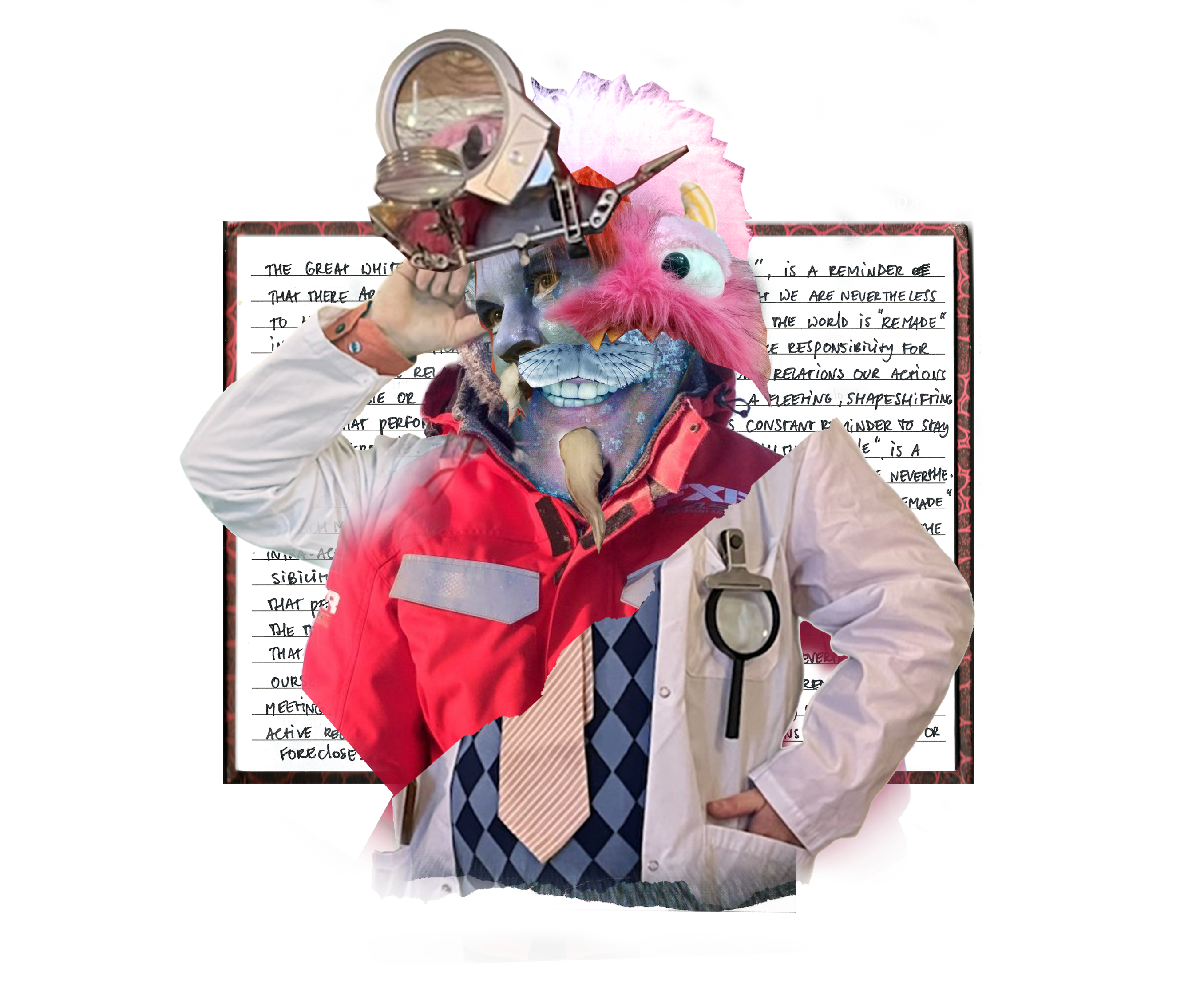Learning About Staying With the Trouble: Difference between revisions
No edit summary |
No edit summary |
||
| (12 intermediate revisions by one other user not shown) | |||
| Line 1: | Line 1: | ||
[[File:Great White Beast.png|thumb]] | |||
You have encountered a Great White Beast! | |||
The Great White Beast is a fleeting, shapeshifting figure that performs the world as "indeterminate". | |||
Although it holds a reference to polar bears, or more accurately- a moniker that is employed within Inuit traditional customs- to respectfully avoid talking about polar bears’<ref>Jimmy Qirqut, Gjoa Haven Elder, interview conducted in 2022</ref>, this figure gestures towards the "Great White Beasts" of indetermination. | |||
<span class="pop-up wrecksite link" data-page-title="Learning About Wrecksites">[[Learning About Wrecksites]]</span> | It is in the spirit of this last frame that the figure of the "Great White Beast" performs in this Knowledge-Land-Scape. As an invitation to stay with the trouble: a 'learning to be truly present, not as a vanishing pivot between awful or edenic pasts and apocalyptic or salvific futures, but as moral critters entwined in myriad unfinished configurations of place, times, matters, and meanings.”<ref>Haraway, D. J. (2016 p.1). Staying with the trouble: Making kin in the Chthulucene. In Staying with the Trouble. Duke University Press.</ref> | ||
Encountering a Great White Beast, reminds us that there are no right decisions to be made, but that we are nevertheless to account for our decisions. Especially when there are no simple or right answers.<ref>Rosiek, J., & Adkins-Cartee, M. (2023 p.160). Diffracting structure/agency dichotomies, wave/particle dualities, and the citational politics of settler colonial scholars engaging Indigenous studies literature. Cultural Studies↔ Critical Methodologies, 23(2), 157-169.</ref> | |||
Great White Beasts provide insights into the im/possibilities of such decisions, and the futurities I have aimed to contribute towards during my research, even if they can not all be addressed within this Knowledge-Land-Scape. | |||
<div class="next_choice"> As you struggle with this Great White Beast, you suddenly remember that someone told you about a very old and well-known shipwreck close-by. | |||
Go find the '''"Shipwreck"'''. | |||
Perhaps it will provide refuge and provide you with some final insight before you exit this tutorial and enter the Knowledge-Land-Scape. </div> | |||
<small><references /></small> | |||
<span class="pop-up wrecksite link" data-page-title=" Learning About Wrecksites " data-encounter-type="Wrecksite">[[Learning About Wrecksites|Wrecksite: Learning About Wrecksites]]</span> | |||
Latest revision as of 19:40, 16 May 2025

You have encountered a Great White Beast!
The Great White Beast is a fleeting, shapeshifting figure that performs the world as "indeterminate".
Although it holds a reference to polar bears, or more accurately- a moniker that is employed within Inuit traditional customs- to respectfully avoid talking about polar bears’[1], this figure gestures towards the "Great White Beasts" of indetermination.
It is in the spirit of this last frame that the figure of the "Great White Beast" performs in this Knowledge-Land-Scape. As an invitation to stay with the trouble: a 'learning to be truly present, not as a vanishing pivot between awful or edenic pasts and apocalyptic or salvific futures, but as moral critters entwined in myriad unfinished configurations of place, times, matters, and meanings.”[2]
Encountering a Great White Beast, reminds us that there are no right decisions to be made, but that we are nevertheless to account for our decisions. Especially when there are no simple or right answers.[3]
Great White Beasts provide insights into the im/possibilities of such decisions, and the futurities I have aimed to contribute towards during my research, even if they can not all be addressed within this Knowledge-Land-Scape.
Go find the "Shipwreck".
- ↑ Jimmy Qirqut, Gjoa Haven Elder, interview conducted in 2022
- ↑ Haraway, D. J. (2016 p.1). Staying with the trouble: Making kin in the Chthulucene. In Staying with the Trouble. Duke University Press.
- ↑ Rosiek, J., & Adkins-Cartee, M. (2023 p.160). Diffracting structure/agency dichotomies, wave/particle dualities, and the citational politics of settler colonial scholars engaging Indigenous studies literature. Cultural Studies↔ Critical Methodologies, 23(2), 157-169.
